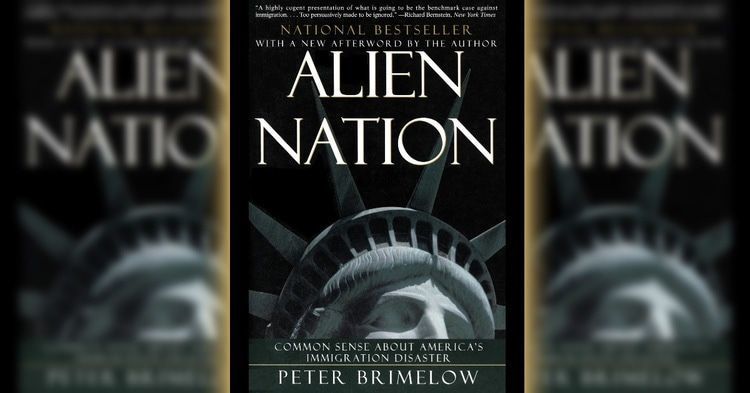
Review of Alien Nation: The American Enterprise
07/01/1995
MIGRANT HEADACHE
By Richard Estrada
The American Enterprise July-August 1995 v6 n4 p90(2)
Alien Nation: Common Sense About America’s Immigration Disaster
By Peter Brimelow
(Random House: New York)
327 pages, $24
In Alien Nation: Common Sense About America’s Immigration Disaster, Peter Brimelow employs the literary device of personalizing a highly complex national debate. He achieves this by reviewing his relevant exchanges with Julian Simon, the University of Maryland business administration professor whom he considers to be his principal adversary. Indeed, these two highly intelligent individuals do an able job of representing different segments of the political Right. Significantly, however, the rational center is not represented in this book.
Public opinion polls have long found public concern over a continuing wave of immigration that since 1970 has added 25 million newcomers and their children to the population of America’s cities. While illegal immigration receives the lion’s share of attention in the media, the debate increasingly focuses on legal immigration, which provides over two-thirds of newcomers to America. Brimelow’s reference to two waves notwithstanding, experts speak of four immigration waves. Currently, the Fourth Wave is running at more than one million newcomers a year. In contrast to previous waves, the current one is dominated by Latin Americans and Asians, as opposed to Europeans.
A senior editor at Forbes, the author bemoans the "more is better" libertarian economic impulses that have re-emerged in the immigration debate in recent years. In 1990 this viewpoint was taken to its logical extremity when the editorial page of the Wall Street Journal proposed the following five-word amendment to the Constitution: "There shall be open borders." Libertarian immigration enthusiasm helped persuade Congress to substantially raise the levels of legal immigration in 1990.
Brimelow’s argument that the economic benefits of immigration have been grossly overblown may be debatable, but it is well documented and deserves a serious response. He notes that publicly funded social-service costs for newcomers harm public budgets. This is particularly true in localities and states that are disproportionately affected by immigration. (Perhaps 75 percent of all newcomers settle in just six states — California, Texas, Florida, New York, New Jersey, and Illinois.)
Economics aside, however, it is the twin issues of race and culture that are the warp and woof of this book. The author essentially argues that U.S. immigration today is counterproductive insofar as there are too many unassimilable Third World newcomers in a nation founded by people of English stock. Himself a British immigrant, Brimelow endorses the traditional European notion that equates membership in the polity with bloodline.
Brimelow ignores the fact that in addition to Americans of European origin there are millions of hard-working and productive African Americans, Hispanic Americans, Asian Americans, and others who proudly exalt their citizenship over their race and ethnicity. They genuflect before America’s traditional civic culture. But the national motto of e pluribus unum is apparently Greek to Brimelow.
Where the author scores a bull’s eye is in noting that contemporary immigration is helping feed a multiculturalism that at times seems to augur outright Balkanization. Something is undermining assimilation today. If race and culture aren’t the culprit, what is? Policymakers should consider the issue of numbers and basic historical differences.
While Brimelow criticizes the family reunification provision in the landmark 1965 immigration act that gave rise, unintentionally, to unforeseen Latin and Asian chain migration, I believe the real shortcomings of our current system lie in its indifference to the numbers and preparedness of today’s immigrants. After a great lull in immigration from the late-1920s through the mid-1960s, the 1965 act re-introduced mass immigration — to a society much different from the one that accepted immigrant waves around the turn of the century.
During the nineteenth and early twentieth centuries, America was industrializing. Today’s immigration is the first wave to occur in the post-industrial era. To be sure, some scholars have exaggerated the comparatively low skills and educational levels of today’s newcomers, because they mistakenly compare them to relatively high-skilled refugees who entered during the immigration lull. When current Fourth Wave immigrants are compared to Third Wave immigrants, the skills and educational levels of the two cohorts are broadly comparable. This is anything but reassuring, however. The economy today demands far higher skills and educational levels of workers than it did before World War I.
While some influential Republicans in the Senate and House appear to understand the need to dovetail immigrant numbers with their skills and educational preparedness, others may not. As recently as a May 9, 1995 speech to the Cato Institute, Dick Armey, the majority leader of the U.S. House of Representatives and a former economics professor, supported still higher levels of legal immigration to the United States without any reference to improving our selection criteria.
Four major options are arrayed before policymakers today. One is immigration reform that would limit automatic family-member entries to spouses, children, and parents only, while putting greater weight on needed skills and educational qualities in selecting merit-based immigrants. Or, reform could tinker on the margins of the status quo. A third option would be to increase emphasis on race and culture when selecting immigrants. This may or may not include a moratorium on new arrivals. And a final choice would be to pursue the libertarian philosophy and allow a dramatic expansion of immigrant numbers.
Those who wish to use Brimelow’s book as a guide to understanding the immigration issue should do so carefully. He is at his best in skewering a truly outdated system that rewards fraud and mendacity, while punishing capable applicants who obey the law. Readers will want to weigh carefully, however, the wisdom of Brimelow’s focus on race, while keeping in mind that concerns about immigration are not necessarily racist or xenophobic.
Richard Estrada is associate editor of the Dallas Morning News editorial page.
